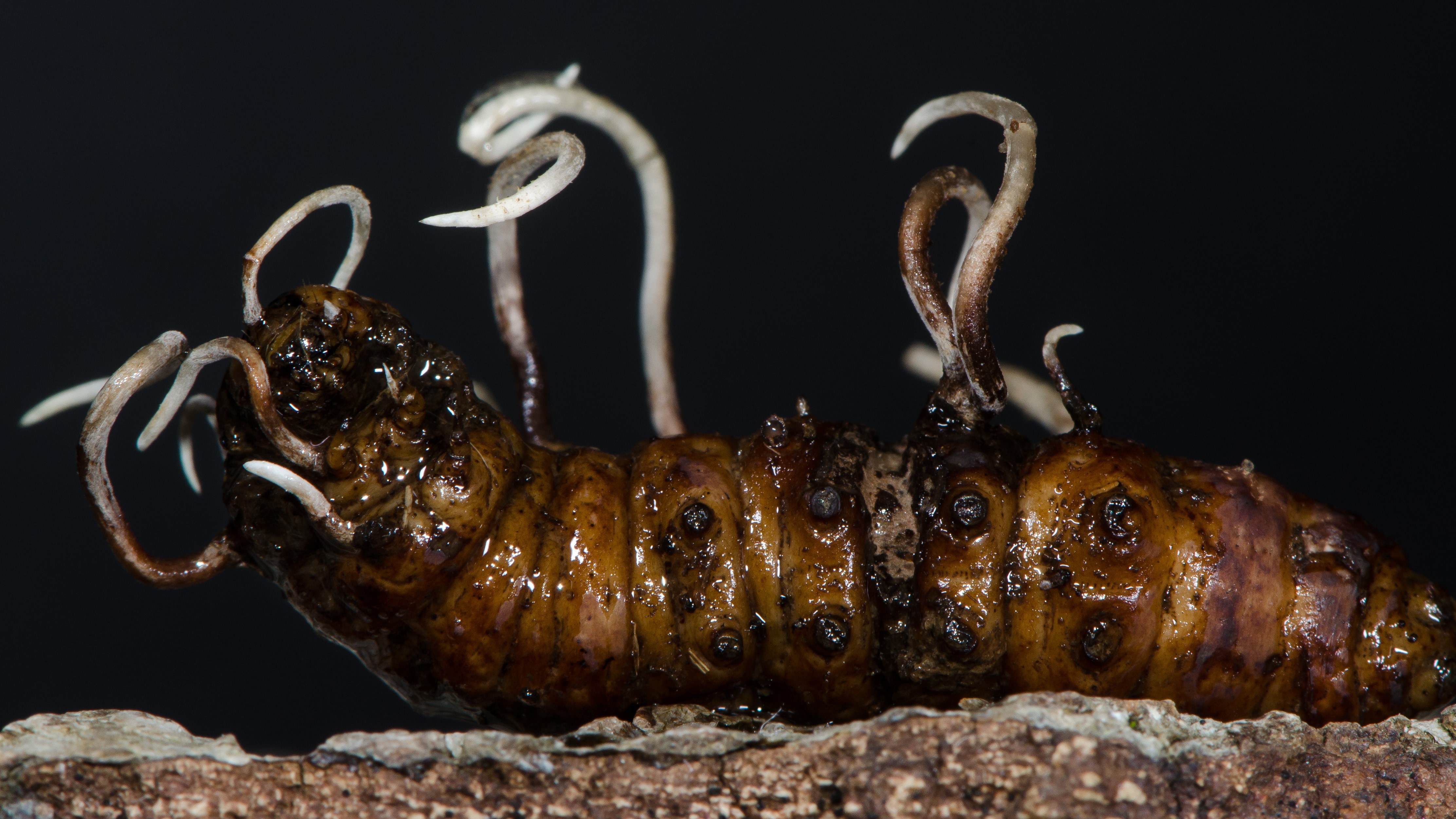'Few insect orders have been spared': Why death by parasite keeps life in the forest thriving
"The fungus swiftly colonizes and liquefies the caterpillar's delicate innards via powerful enzymes that pervade the creature's entire body cavity, effectively consuming the caterpillar from the inside out."
There are around 1,000 known species of parasitic fungi, which infest and feed on their insect hosts until just a shell remains. In the adapted excerpt below, from "Meetings with Remarkable Mushrooms" (The University of Chicago Press, 2023), Alison Pouliot encounters a species that targets the larvae of ghost moths, revealing how deadly fungi bring balance to the forest.
I was in the depths of north-west Tasmania's Tarkine Forest when I spied a stick that looked suspiciously like it might not be a stick.
Going by its size, it was probably more twig than stick, but I didn't think it was a twig either. Its slightly pointed tip and slender stature was the first clue to another identity. Running my fingers down its length I felt its fine sandpaper-like texture hinting at something non-twig. Sizing up the rather emaciated-looking thing, I reckoned it might in fact be a special type of fungus. Beneath the ground, I suspected there might be a caterpillar attached, on which the fungus fed. I carefully excavated the soil around the "twig" with my pocketknife.
Brushing the soil away with my hand, I dug a little further and, sure enough, the perfect mummified form of a caterpillar magically materialized. This unassuming twig-like sporing body of the vegetable caterpillar is easily overlooked. Originally named Cordyceps robertsii, it was the first vegetable caterpillar fungus scientifically recorded in Australasia — in New Zealand in 1836 — and is probably one of the largest in the world.
While many fungi parasitize plants, vegetable caterpillars seek out invertebrate hosts. Despite their common name, they don't just grow on caterpillars but on a great variety of arthropods, as well as the occasional truffle. Known as Ophiocordyceps robertsii today, this fungus usually targets moth larvae from the family Hepialidae, such as the Victorian swift moth.
Related: Horrifying photo captures moment parasitic fungus bursts from huge spider's body
During the larval stage of their lives, caterpillars spend time mostly beneath the soil in the silk-lined shafts of their burrows. Under cover of darkness, they emerge to forage among the leaf litter. Although darkness might spare them from daytime predators, life in the litter presents multiple risks to a caterpillar, not least the chance of encountering fungus spores. Most of the millions of spores a caterpillar is likely to meet do not pose any great threat.
Get the world’s most fascinating discoveries delivered straight to your inbox.
Those of O. robertsii are another story. How caterpillars become infected with O. robertsii spores is a mystery. Caterpillars breathe through tiny holes called spiracles on their abdomens, so they may unintentionally inhale spores, or perhaps they brush up against spores that have already sprouted hyphae. The hyphae may then dissolve the caterpillar's cuticle (outer layer) with enzymes, allowing the fungus to penetrate its innards.
It seems more likely that the caterpillar consumes the spores along with the organic matter on which it feeds but, whichever way the fungus finds its way into the caterpillar, it's a coup de grâce for the luckless creature. Once the fungus is inside, the caterpillar's interior provides the ideal habitat for the mycelium to proliferate.
The fungus swiftly colonizes and liquefies the caterpillar's delicate innards via powerful enzymes that pervade the creature's entire body cavity, effectively consuming the caterpillar from the inside out. In the process, the fungus kills the caterpillar and transforms it into something resembling a fungal mummy (known as a sclerotium).
Once satiated, the fungus sends its reproductive structure out through the head of the caterpillar and above the soil surface. It releases its spores out of tiny receptacles called perithecia (minute pores in the perithecia, called ostioles, underground lovers give it the sandpaper-like texture I felt with my hand), and they are dispersed by wind and passing animals that happen to brush against the fungus. And so the cycle begins again.
I turned the segmented, mummified remains of the parasitized caterpillar over in my hand. I hadn't witnessed the process of its demise in the darkness of the subterrain, just the leftovers of a fungus's meal. Mulling over the caterpillar and the unassuming twig-like sporing body, I wondered how this bizarre union might play out at an ecosystem scale. Vegetable caterpillars are highly specialized fungi.
They have evolved a swag of tricks and chemicals that enable them to manipulate the physiology and behavior of their hosts, inspiring scientists and science fiction writers alike.
Along with other entomopathogenic fungi (those that grow in or on the bodies of insects), they play an important role in regulating populations of insects and other arthropods such as centipedes, spiders, and scorpions. Arthropods, like fungi, are vital to forest function. At times, forest conditions can change in such a way that they favor a particular species or group of arthropods.
These changed conditions can result from local disturbances such as fire or forestry, or more global processes such as climate change. Taking advantage of the new favorable conditions, an arthropod species can multiply rapidly. The increased pressure of a population explosion on forest resources can trigger a slew of effects. These can deplete resources for other forest inhabitants, and dramatically alter forest dynamics. This is where the parasitic nature of vegetable caterpillars can do the forest a favor.
Most species of vegetable caterpillar have limited host ranges, meaning they only associate with a small number of species. For example, one might target a particular ant genus; another might be restricted to a particular beetle genus. This specificity means they are likely to play a role in regulating arthropod population dynamics.
By preventing any one genus or species of arthropod from gaining the upper hand, they help keep ecosystems stable. Few insect orders have been spared, with vegetable caterpillars capable of infecting the majority. Several hundred species of vegetable caterpillars have been described worldwide, occupying diverse habitats from rainforests to alpine environments and deserts. In forests they are found in soil, leaf litter, the canopy, and almost everywhere in between.
The best-studied group of vegetable caterpillars, however, are those that parasitize ants.
Much has been written about the so-called "zombie-ant fungi" of the O. unilateralis clade, which can modify ant behavior. This species penetrates the ant's cuticle, infiltrating its body, invading and commandeering its muscles. The ant effectively becomes a prisoner in its own body as the fungus swiftly takes the reins and compels it to climb a plant stem. Here the fungus releases chemicals that direct the contraction of the ant's jaw muscles, forcing it to latch on to the underside of a leaf.
With its body cavity now flooded with the mycelium of the fungus, the ant dies. From this elevated vantage point, the fungus sends its spore-laden reproductive structure out through the head of the ant, raining spores on its unlucky ant allies below.
Reprinted with permission from Meetings with Remarkable Mushrooms by Alison Pouliot, published by The University of Chicago Press. © 2023 by Alison Pouliot. All rights reserved.
Meetings with Remarkable Mushrooms: Forays with Fungi across Hemispheres - $16.51 on Amazon
A whirlwind journey through fungus frontiers that underscores how appreciating fungi is key to understanding our planet’s power and fragility.
What can we learn from the lives of fungi? Splitting time between the northern and southern hemispheres, ecologist Alison Pouliot ensures that she experiences two autumns per year in the pursuit of fungi—from Australia’s deserts to Iceland’s glaciers to America’s Cascade Mountains. In Meetings with Remarkable Mushrooms, we journey alongside Pouliot, magnifiers in hand, as she travels the world.

Alison Pouliot is an ecologist and photographer with a passion for fungi.







